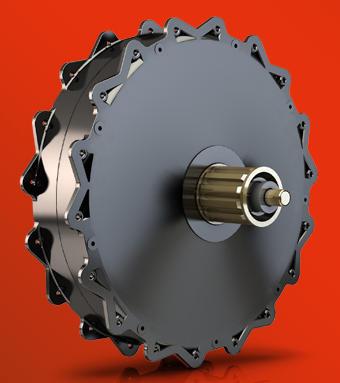A Catrike Trail E-Cat accessorized with a Shimano Alfine-8 drivetrain upgrade, Racktime rear rack with integrating basket, phone-mount, and extra mirror using AlphaBENT accessory mounts.
You are here
Compare weight: 500W Bionx v. 500W GoSwiss 26" wheel
It's not every day that we have the opportunity to measure the weights of different systems. Usually, everything is so intertwined with everything else, that it's hard to pin down exact weight differences of comparable items and components.
Recently, though, we had the opportunity to measure two comparable 500W 26" wheels with very different motor systems by Bionx and GoSwiss, so we chucked them up on the doctor's scale.
The Bionx motor has a huge diameter. Instead of the conventional large-hub system with a conventional spoke flange, Bionx has made the motor into a large disc that sits inside the spokes of the wheel and the spokes are a newer-style straight-pull variety that travel parallel to the motor case. This motor is very thin, but shows a large profile from the side. It looks quite large.
The GoSwiss motor hub uses conventional J-bend spokes with conventional flanges. The sideways diameter of the motor is much smaller than the Bionx, but the motor is much wider.
Given that both motors consume 500W, it might be reasonable to assume that if they use the same technology, then the internal windings would probably have a very similar weight. If anything, it appears visually that the larger diameter Bionx motor would weigh more.
We were quite surprised to find that the Bionx wheel was significantly lighter than the GoSwiss.
Our shop scale is a well-calibrated doctor's scale. It has a resolution of about 1-2 ounce (or about 50g). The wheels were measured with no tire, tube, or cassette.
The Bionx wheel weighed 5lb-4oz or 2380g. The GoSwiss wheel weighed 6lb-8oz or 2950g.
This is a very simple rough comparison of a single characteristic and does not measure comparable power output, acceleration, nor efficiency of the motors. It also does not include batteries, racks, or other auxiliary equipment.
It is also true that a mere 1+ pound of difference in a single component of a system that will have an overall weight in the 60lb range is relatively minor and insignificant.
[NOTE: This just an interesting fact about a measurable characteristic. We install and use both of these systems and find both to be quite impressive technologically.]
Image gallery
Information
A fire in the early morning of 5 June 2024 destroyed our neighbor business, MidCentury Sacramento. AlphaBENT escaped the worst of it and is back up and running.
Classifieds
Azub, Bionx, Catrike, GoSwiss, ICE, HP Velotechnik, Greenspeed
Join AlphaBENT in welcoming HP Velotechnik during their 2017 West Coast Tour.





